Practical Compliance Guideline
PCG 2017/8
Income tax - the use of internal derivatives by multinational banks
| Table of Contents | Paragraph |
|---|---|
| What this Guideline is about | |
| Date of effect | |
| Circumstances in which this Guideline can be used | |
| Compliance Framework | |
| Profit Attribution | |
| Consistent tax treatment | |
| Level of analysis and documentation | |
| Complexity framework | |
| Indicators of low complexity transactions | |
| Indicators of medium complexity transactions | |
| Indicators of high complexity transactions | |
| Examples of complexity | |
| Low complexity scenarios | |
| Medium complexity scenarios | |
| High complexity scenarios | |
| Scenarios Dealing with Transactions that are Outside the Scope of this Guideline |
|
Relying on this Guideline
This Practical Compliance Guideline sets out a practical administration approach to assist taxpayers in complying with relevant tax laws. Provided you follow this guideline in good faith, the Commissioner will administer the law in accordance with this approach. |
What this Guideline is about
1. The Commissioner's views on the operation of Australia's permanent establishment attribution rules and the application of those attribution rules to certain funding activities of banks are set out in detail in Taxation Rulings TR 2001/11 Income tax: international transfer pricing - operation of Australia's permanent establishment attribution rules and TR 2005/11 Income tax: branch funding for multinational banks respectively.
2. This Guideline extends the Commissioner's practical approach to applying the arm's length principles adopted in those taxation rulings to internal derivatives of multinational banks. It sets out the circumstances in which internal derivatives, that represent arm's length dealings, can be used as an appropriate proxy for the purposes of allocating or attributing a bank's income (gains), expenses (losses) or profit[1] for the purposes of Subdivision 815-C of the Income Tax Assessment Act 1997 (ITAA 1997).
3. This Guideline also provides guidance on the Commissioner's compliance expectations for banks seeking to rely on it. It considers a number of scenarios involving the use of internal derivatives and groups them according to their complexity level. Complexity is an indication of the level of analysis the Commissioner expects a bank to have undertaken in order to support the attribution outcome produced by reference to the internal derivative. Banks should also expect that higher complexity transactions will be subject to a greater level of scrutiny by the Commissioner in any review of the bank's activities.
4. For the purposes of this Guideline, internal derivatives are derivative transactions between the head office of a bank and a permanent establishment (branch), or between two branches of the bank.
5. When a bank enters into a transaction with a third party in which it assumes exposure to some form of financial risk, the bank might use a notional internal derivative to reflect the fact that some, or all, of that risk is managed in its head office and/or one or more of its branches that are located in another jurisdiction. As these internal derivatives are entered into by different parts of the same legal entity, they are not legal transactions and are only internally characterised and recorded as derivatives. They are used by the bank, among other things, to allocate (for its own internal purposes) the gains and losses from third party transactions to the appropriate jurisdiction in accordance with its risk management approach.
Date of effect
6. In general, this Guideline applies to years commencing both before and after its date of issue. For Australian resident banks, this Guideline replaces a previous Guideline issued on 31 October 2014 to the Australian Bankers Association, 'Internal Derivatives Guidelines', which applied to income tax returns lodged on or after the date of issue. For Australian resident banks, the date of application for this Guideline will align with the previous Guideline, that is, returns lodged on or after 31 October 2014. In addition, the Guideline does not apply to banks to the extent that it conflicts with the terms of a settlement of a dispute agreed to before the date of issue of this Guideline.
Circumstances in which this Guideline can be used
7. This Guideline applies both to Australian resident banks with foreign branches and to banks that are not Australian residents (foreign banks) with Australian branches. For the purposes of this Guideline, a bank is a body corporate that has been granted a banking licence to operate a banking business in Australia as an 'authorised deposit-taking institution' under the Banking Act 1959.
8. Subject to paragraph 10 below, this Guideline applies to all internal derivatives that are not expressly recognised by the income tax laws, including:
- (a)
- interest rate forwards (such as forward rate agreements) and interest rate swaps
- (b)
- interest rate options (such as interest rate caps and floors)
- (c)
- currency swaps
- (d)
- currency forwards
- (e)
- currency options
- (f)
- derivatives on other asset classes (such as credit, commodities and equity).
9. This Guideline does not apply to internal derivatives expressly recognised by the income tax law, including:
- (a)
- internal derivatives between an offshore banking unit (OBU) and its overseas permanent establishment that are treated as being entered into by separate persons under section 121EB(1) Income Tax Assessment Act 1936 (ITAA 1936).
- (b)
- internal derivatives entered into by an Australian branch of a foreign bank (within the meanings of section 160ZZV of the ITAA 1936) that are treated as if they were entered into by separate legal entities under section Part IIIB of the ITAA 1936.
10. Some arrangements involving the use of internal derivatives may fall outside the scope of this Guideline. For example, this Guideline does not apply to some internal derivatives entered into as part of a highly structured transaction outside the ordinary course of a bank's trading business (as illustrated in scenario 12 at paragraphs 61 and 62 of this Guideline) or to internal derivatives that cannot be justified based on the functional profile of the branch (or head office). If you are unsure whether this Guideline applies to an arrangement, particularly if it is high complexity, please contact us to discuss your particular circumstances.
Compliance framework
Profit Attribution
11. The Commissioner accepts an internal derivative that represents an arm's length dealing can, in appropriate circumstances, be used as a proxy for the actual third party income and expenses allocated to each part of a bank for the purposes of attributing the bank's profits under Division 815-C of the ITAA 1997. Where the internal derivative represents an arm's length dealing and the attribution outcome is the best estimate that can be made in the circumstances of the profits, the Commissioner will not require the bank to allocate the actual third party income and expenses.
12. While the internal derivative does not itself give rise to assessable income or gains, or deductible expenses or losses, the use of internal derivatives as a proxy can produce a tax outcome that is consistent with the allocation or attribution of actual third party income and expenses required by Australia's transfer pricing laws.
13. The attribution of those amounts involves a two-step process as prescribed in Taxation Rulings TR 2001/11 and TR 2005/11. This requires banks to undertake:
- (a)
- a functional analysis, considering functions performed, assets used and risks assumed by each business activity that is part of the bank's global structure to determine the functional profile associated with that activity, and
- (b)
- a comparability analysis to determine an arm's length return for the functions, assets and risks attributed to each part of the bank based on that functional profile.
14. The fact an internal derivative reflects the terms and pricing of an actual third party arm's length transaction is, therefore, not of itself sufficient for the internal derivative to be accepted as an appropriate proxy. It will also need to represent an arm's length dealing between the different parts of the bank, as ascertained by a functional and comparability analysis.
15. If the attribution outcome produced using the internal derivative alone, as a proxy, is not appropriate based on a functional and comparability analysis, the Commissioner may still accept the use of the internal derivative as a partial proxy for determining the attribution of profits. However, the bank will need to make other transfer pricing adjustments to ensure the correct profit attribution is achieved. Similarly, in the absence of an internal derivative, other transfer pricing adjustments may be required to ensure the profit attribution correctly reflects the functional profile of each location - refer scenarios 13 and 14 in paragraphs 63 to 66 of this Guideline.
16. Where an internal derivative can be used as a proxy under this Guideline,[2] then:
- (a)
- for a resident bank, the Commissioner will generally treat amounts appropriately attributed to a branch outside Australia, by reference to the internal derivative, as being non-assessable non-exempt income of the resident bank under section 23AH of the ITAA 1936, and
- (b)
- for a foreign bank, the Commissioner will generally not treat amounts appropriately attributed to a branch outside Australia, by reference to the internal derivative, as assessable income.
Consistent tax treatment
17. Where this Guideline applies to an internal derivative, the Commissioner expects the bank will apply the TOFA provisions in Division 230 of the ITAA 1997 consistently to all derivatives, and treat internal derivatives as if they are financial arrangements.
18. For internal derivatives of foreign banks treated as transactions between separate legal entities under Part IIIB of the ITAA 1936 (which are outside the scope of this Guideline), the applicable transfer pricing provision is Subdivision 815-B of the ITAA 1997. However, irrespective of whether Subdivision 815-B or 815-C of the ITAA 1997 applies to an internal derivative of a foreign bank, the Commissioner would generally expect the outcome produced by a functional and comparability analysis to be the same under both Subdivisions.
Level of analysis and documentation
19. For internal derivatives covered by this Guideline, the ATO compliance approach is to apply an arm's length separate enterprise principle and Australia's transfer pricing rules, having regard to all dealings between the relevant parts of a multinational bank and the outcomes produced by reference to those dealings.
20. The approach is consistent with:
- (a)
- Subdivisions 815-B and 815-C of the ITAA 1997
- (b)
- OECD principles on the attribution of profits to permanent establishments adopted by Australia, and
- (c)
- double tax agreements entered into by Australia.
21. The Commissioner expects banks will prepare and maintain sufficient documentation as outlined in Subdivision 284-E of Schedule 1 to the Taxation Administration Act 1953. Taxation Ruling TR 2014/8 Income tax: transfer pricing documentation and Subdivision 284-E sets out the Commissioner's view on the requirements for transfer pricing documentation. Failure to prepare contemporaneous transfer pricing documentation does not, of itself, mean the Commissioner will not accept the use of the internal derivative for the purposes of determining an arm's length attribution. However, in the event the Commissioner makes a transfer pricing adjustment, and the documentation requirement is not satisfied for the relevant matter, the Commissioner will treat the transfer pricing position adopted by the bank as not being reasonably arguable for penalty purposes.
22. It is the Commissioner's expectation that the complexity of a transaction should guide the level of analysis a bank undertakes in order to support the internal derivative as an appropriate proxy in determining an attribution of profit. Similarly, if the Commissioner reviews a bank's internal derivative arrangements, the extent of compliance resources and the level of analysis undertaken by the Commissioner would also vary depending on the complexity and materiality of the arrangement. Higher complexity transactions may also be more likely to fall outside the scope of this Guideline, although this will be determined by the functional and comparability analysis rather than the level of complexity.
23. The Commissioner has considered a number of scenarios involving the use of internal derivatives by banks in the ordinary course of their trading business and grouped these according to the level of complexity.
24. Where the internal derivative forms part of a low complexity transaction, the Commissioner will accept that a lower level of analysis and documentary evidence will generally be sufficient to support the attribution outcome produced by reference to the internal derivative. The level of analysis and documentary requirements will progressively increase for internal derivatives that form part of medium and high complexity arrangements.
25. These expectations regarding the bank's level of analysis and documentary support are not meant to be prescriptive. While this Guideline provides guidance on the level of analysis and documentary evidence required, banks need to exercise their own judgment about the nature and extent of analysis and documentation appropriate to each arrangement and their particular circumstances.
Complexity framework
26. The Commissioner will use a framework based on complexity and materiality to guide compliance activity in respect of a bank's internal derivatives. The examples provided in this Guideline assist in the classification of the complexity of arrangements. The compliance approach outlined in this Guideline is not limited only to the examples contained in this Guideline, and it may apply to other scenarios involving internal derivatives.
Indicators of low complexity transactions
27. The low complexity scenarios are generally those where the financial risk of an unrelated third party derivative transaction entered into in the ordinary course of the bank's trading business is immediately moved to the location where that risk is managed on a portfolio basis. The internal derivative reflects the fact the risk exposure arising from the third party transaction is effectively located in the jurisdiction of the trader managing that risk.
28. The internal derivative is a mirror of the third party derivative on all factors, or all factors other than on price. The internal derivative may be priced so as to result in a sales margin, spread or equivalent amount being attributed to the branch (or head office) in order to appropriately compensate the function performed by that branch (or head office).
29. In these circumstances, the commercial justification for the use of the internal derivative is clear and there is a reference transaction (the third party derivative) that is relevant to determining the arm's length price. The Commissioner would not expect or require extensive documentation to have been prepared by the bank to justify that the outcome produced by reference to the internal derivative is appropriate.
30. Low complexity transactions present all the following features:
- (a)
- the internal derivative can be shown to relate directly to an unrelated third party derivative transaction
- (b)
- the terms of the internal derivative mirror or closely mirror the terms of the third party derivative, though the pricing may allow an economic function that is performed by another part of the bank to be rewarded
- (c)
- the internal derivative is recorded in the bank's accounts contemporaneously with the third party derivative
- (d)
- the internal derivative reflects the fact the bank's risk from the third party derivative resides in the jurisdiction that maintains that particular risk management/trading function, which is able to be justified based on the functional profile of the bank
- (e)
- the trading/risk management function is undertaken by a trader who manages the relevant risk on a portfolio basis
- (f)
- changes to or termination of the internal derivative are driven by the third party derivative to which the internal derivative directly relates.
Indicators of medium complexity transactions
31. Medium complexity scenarios reference an unrelated third party transaction, but the internal derivative does not directly match that third party transaction. This could arise where only some of the components of risk associated with the third party transaction are moved to another location.
32. In these circumstances, it is more difficult to verify the pricing and terms of the internal derivative is appropriate, as there is no directly matching third party derivative transaction. A greater level of analysis is therefore required to support the attribution outcome produced by reference to the internal derivative.
33. Scenarios will be considered as medium complexity where they have some but not all the features of a low complexity scenario[3] and present any of the following features:
- (a)
- the internal derivative directly relates to only a part of an actual third party transaction
- (b)
- multiple internal derivatives relate to a single third party transaction.
Indicators of high complexity transactions
34. High complexity scenarios are any internal derivative transactions that are not low or medium complexity transactions. They may reference a third party transaction on materially different terms, be entered into between locations that do not manage that risk or may not reference a third party transaction at all.
35. It is difficult to verify that all aspects of the internal derivative in high complexity scenarios are consistent with an arm's length dealing, hence the need for a higher level of analysis and review. In some cases, it may also be difficult for the bank to justify the commerciality of the transaction and demonstrate compliance with transfer pricing legislation. As such, for some high complexity scenarios, the use of the internal derivative may not be justified based on the functional profile and it may fall outside the scope of this Guideline.
36. High complexity scenarios include those that present any of the following features:
- (a)
- the internal derivative does not relate directly to any actual third party transaction and may transfer a net position (as in the case of a bulk risk transfer)
- (b)
- the reference transaction is entered into with a related party (or another part of the bank itself)
- (c)
- the internal derivative is difficult to justify based on the functional profile of the bank (for example, neither location manages that particular risk)
- (d)
- the internal derivative results in tax treatment that is inconsistent with the functional profile of the bank (for example, as a result of the application of the hedging financial arrangement method to gains under the TOFA provisions in Division 230 of the ITAA 1997)
- (e)
- the internal derivative directly relates to a third party transaction but the pricing and/or terms are materially different from the third party transaction
- (f)
- the internal derivative is not entered into contemporaneously with the third party transaction
- (g)
- changes to or termination of the internal derivative are not driven by third party transactions, but by internal management decisions.
Examples of complexity
Low complexity scenarios
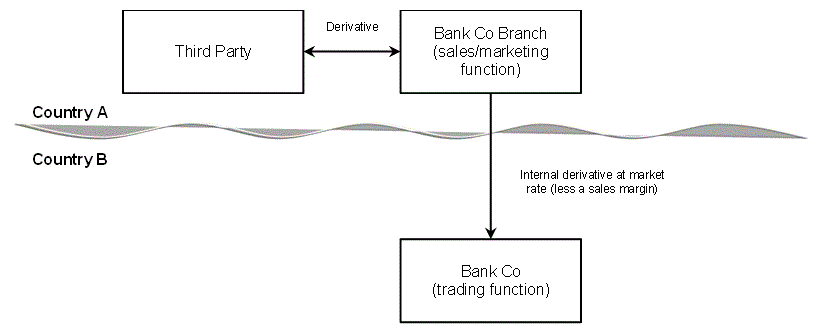
37. A third party enters into a derivative with Bank Co's sales/marketers located in the Bank Co Branch (Country A). There is a matching internal derivative recorded contemporaneously between Bank Co Branch and Bank Co (head office in Country B), which is the location of the trader managing the risk on that particular class of derivative. The internal derivative mirrors the third party derivative, or mirrors it in all factors other than price, such as to leave an arm's length sales margin in Bank Co Branch.
38. The proper attribution and allocation of gains and losses as between different parts of the bank based on the arm's length separate enterprise principle can be easily ascertained, and the arrangement should be considered low complexity.
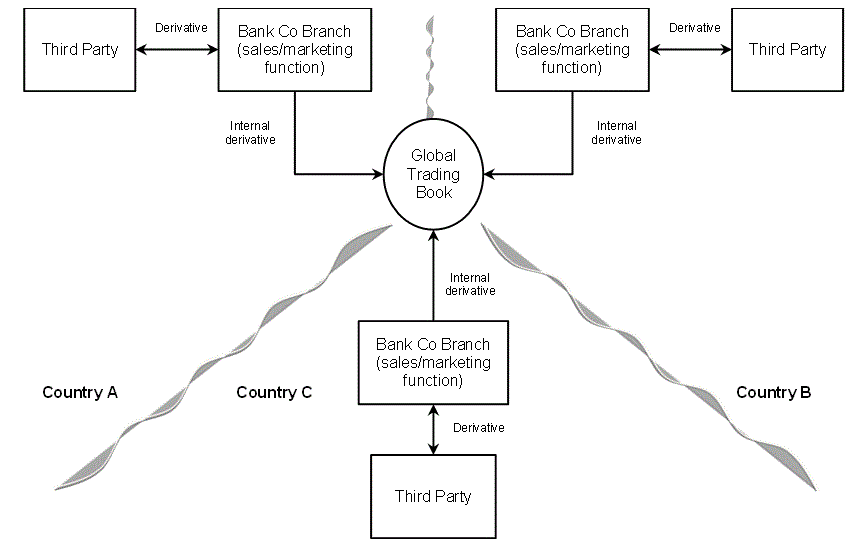
39. Third parties enter into a derivative with sales/marketers located in various Bank Co branches. Each branch enters into a matching internal derivative that contemporaneously records the position into a global trading book where traders in multiple jurisdictions manage the risk on that particular class of derivative. Each internal derivative mirrors a third party derivative, or mirrors it by all factors other than price, such as to leave an arm's length sales margin in the respective branch.
40. The proper attribution and allocation of gains and losses of the sales and marketing function as between different parts of the bank based on the arm's length separate enterprise principle can be easily ascertained, and the arrangement should be considered low complexity in respect of the sales/marketing functions.
41. However, unlike the sales and marketing function, the attribution of gains and losses of the trading function is more complex than in Scenario 1 and would not be considered low complexity. A more detailed functional and comparability analysis is required to determine whether the attribution outcome determined by reference to the internal derivative is appropriate based on the functional profile.
Medium complexity scenarios
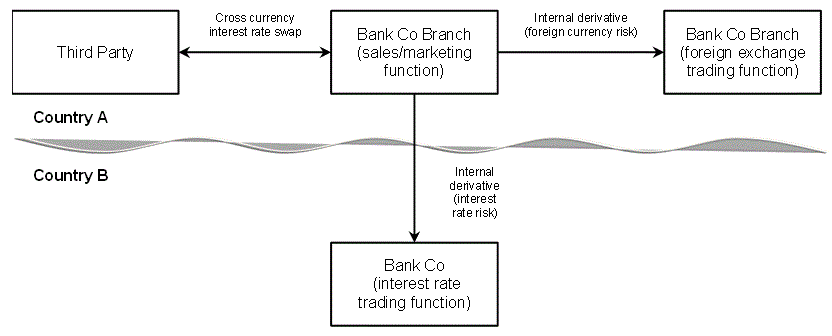
42. A third party enters into a cross currency interest rate swap with Bank Co Branch (Country A). The risk is separated into different components that are hedged individually. An internal foreign exchange derivative is entered into with a trader managing foreign exchange risk in Bank Co Branch (Country A). An internal interest rate swap is entered into with a trader in Bank Co (Country B) who manages interest rate risk.
43. The proper attribution and allocation of gains and losses as between different parts of the bank based on the arm's length separate enterprise principle is more complex than the low complexity scenarios. The bank should expect that the Commissioner will undertake a more detailed functional and comparability analysis to determine if the outcome produced, by reference to the internal derivative, is in line with the arm's length separate enterprise principle.
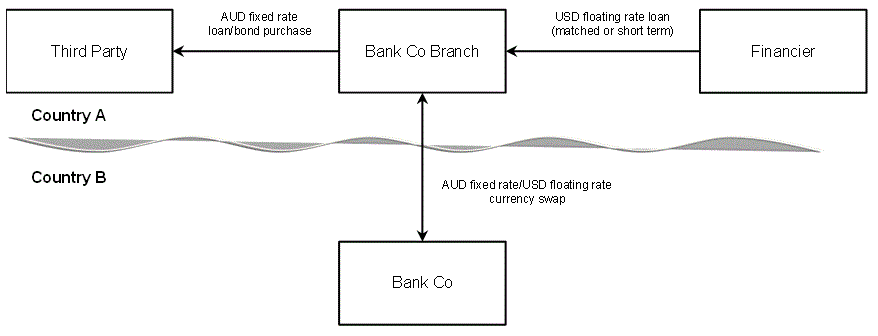
44. Bank Co Branch (Country A) makes a fixed rate loan to, or purchases a bond from, a third party. Bank Co Branch funds the loan (or bond) with a floating rate loan in a different currency from a third party financier. The interest rate and currency risk associated with the two third party transactions are hedged under a single internal derivative with Bank Co (Country B) who manages interest rate and currency risk.
45. The proper attribution and allocation of gains and losses as between different parts of the bank is more complex than the low complexity scenarios. The bank should expect that the Commissioner will undertake a more detailed functional and comparability analysis in determining whether the outcome produced, by reference to the internal derivative, is in line with the arm's length separate enterprise principle.
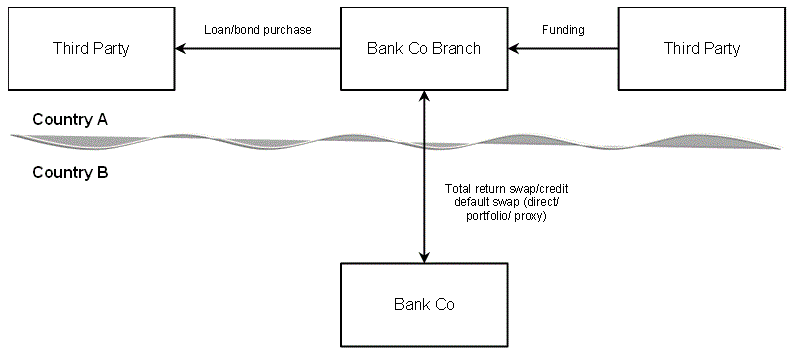
46. Bank Co Branch, in Country A, makes a loan to, or purchases a bond from, a third party. The Bank Co Branch funds the loan (or bond). The Bank Co Branch hedges the credit or default risk of the loan (or bond) using a total return swap, a credit default swap or a put option. The Bank Co Branch enters into this internal derivative with the head office of Bank Co (Country B).
47. The proper attribution and allocation of gains and losses as between different parts of the bank is more complex than the low complexity scenarios. The bank should expect that the Commissioner will undertake a more detailed functional and comparability analysis in determining whether the outcome produced by the internal derivative is in line with the arm's length separate enterprise principle.
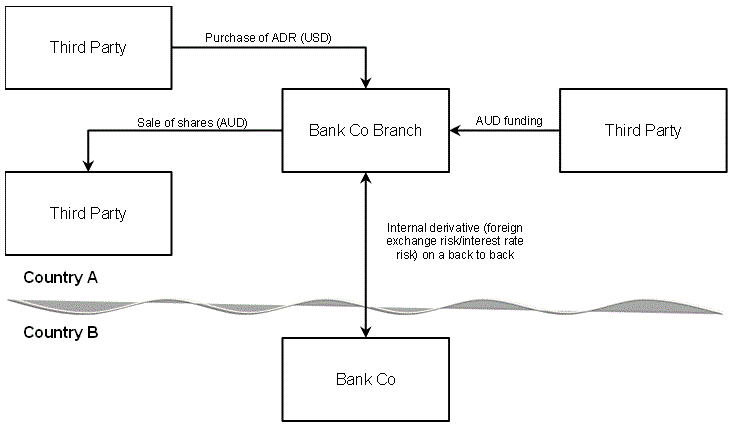
48. Bank Co Branch (Country A) obtains Australian dollar (AUD) funding and purchases an American Depositary Receipt (ADR). The Bank Co Branch hedges the long ADR position by taking an offsetting short position in the underlying Australian shares. Bank Co Branch has residual interest rate or currency risk which is hedged by an internal cross currency swap and/or internal currency forwards and interest rate hedges with Bank Co (Country B), which manages those risks. Economically the bank has reduced its market risk as it has simultaneously bought and sold the shares (or exposure to the shares) in different markets and in different trading formats. The internal derivative(s) may result in gains or losses in Bank Co Branch depending on changes in the AUD/USD interest and foreign exchange rates, which may offset the gains or losses on the third party transactions.
49. The proper attribution and allocation of gains and losses as between different parts of the bank is more complex than the low complexity scenarios. The bank should expect that the Commissioner will undertake a more detailed functional and comparability analysis in determining whether the outcome produced by reference to the internal derivative is in line with the arm's length separate enterprise principle.
High complexity scenarios
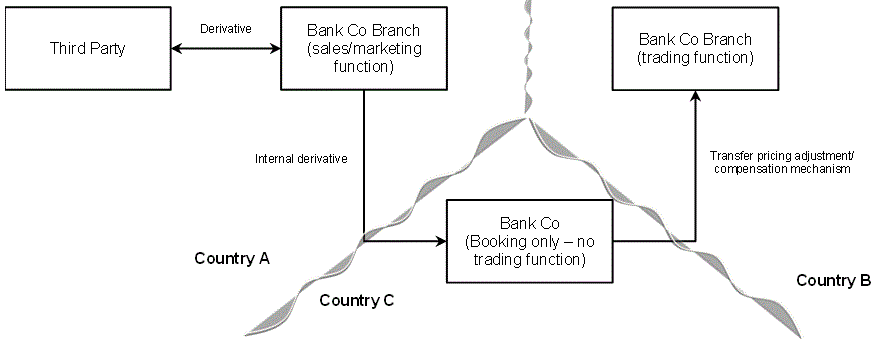
50. A third party enters into a derivative with Bank Co Branch (Country A). There is a matching internal derivative recorded contemporaneously between Bank Co Branch (Country A) and Bank Co (head office in Country C), which is a central booking location. The internal derivative mirrors the third party derivative, or mirrors in all factors other than price (priced to leave an arm's length sales margin in Bank Co Branch in Country A).
51. The financial risk transferred to Bank Co (Country C) is managed by Bank Co Branch (Country B). Bank Co Branch (Country B) is compensated for the trading function it performs through another mechanism, such as a transfer pricing adjustment.
52. The internal derivative between Bank Co Branch (Country A) and Bank Co (Country C) would appear to meet the characteristics of a low complexity scenario outlined in paragraph 30 of this Guidelin e, from the perspective of the sales/marketing function. However, the overall arrangements involving the internal derivative and the transfer pricing adjustment are more complex than the low complexity scenarios. The bank should expect that the Commissioner will undertake a more detailed functional and comparability analysis of all locations in determining whether the outcome produced by reference to the internal derivative and the transfer pricing adjustment is in line with the arm's length separate enterprise principle.
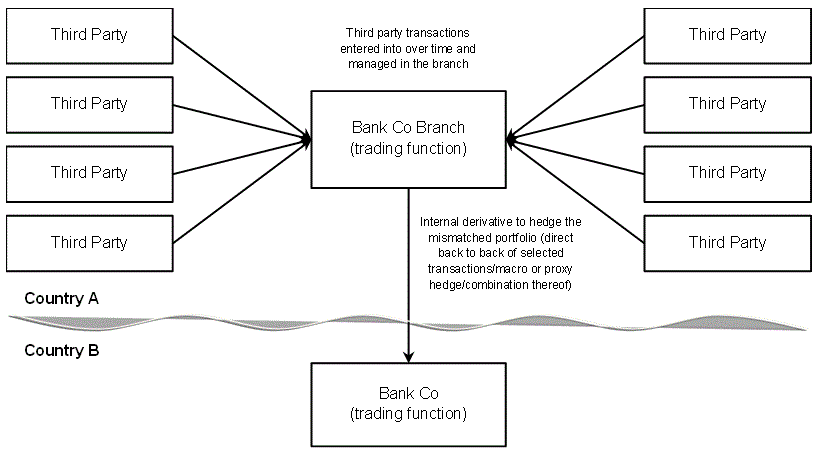
53. A number of mismatched positions arising from various transactions with third parties are managed by a trader in Bank Co Branch (Country A). The trader in Country A enters into internal derivative(s) with a trader located in Bank Co (Country B). The transfer may be motivated by a variety of factors including risk limits, capital issues or naturally offsetting positions in other trading books of Bank Co (Country B). The internal derivatives reflect the transfer of the market risk exposures, shifting all or a portion of the risk to Bank Co (Country B). This may take the form of transferring some positions in a form similar to the original transactions, a macro or proxy hedge, or a combination. In the case of a macro or proxy hedge, transaction(s) is/are entered into to neutralise market risk, as measured by generic risk measures rather than specific matching of underlying risk exposures by similar transactions.
54. The proper attribution and allocation of gains and losses as between different parts of the bank is more complex than the low and medium complexity scenarios. The bank should expect that the Commissioner will undertake an even more detailed functional and comparability analysis in determining whether the outcome produced by reference to the internal derivative is in line with the arm's length separate enterprise principle.
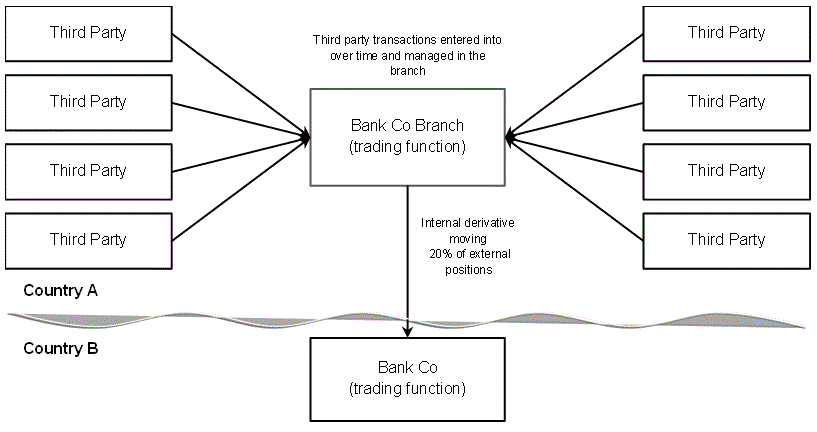
55. Like Scenario 8, a number of market risk exposures are managed by a trader in Bank Co Branch (Country A). This trader enters into internal derivative(s) with another trader located in Bank Co (Country B) to reflect the fact that part of the risk, in this case, 20% of the net market risk exposure, is managed by Bank Co Branch (Country A).
56. The proper attribution and allocation of gains and losses as between different parts of the bank is more complex than the low and medium complexity scenarios. The bank should expect that the Commissioner will undertake an even more detailed functional and comparability analysis in determining whether the outcome produced by reference to the internal derivative is in line with the arm's length separate enterprise principle.
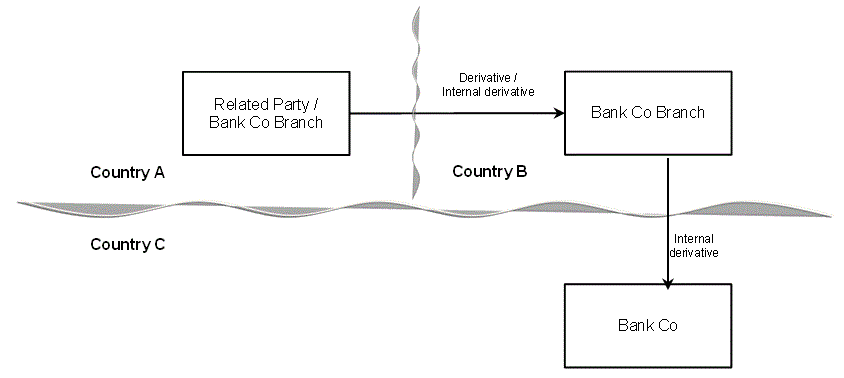
57. This scenario relates to a derivative between a related party and a Bank Co Branch or alternatively, two Bank Co Branches, each located in a different jurisdiction. An internal derivative is entered into between Bank Co Branch (Country B) and Bank Co (Country C) that mirrors the original derivative.
58. The proper attribution and allocation of gains and losses as between different parts of the bank is more complex than the low and medium complexity scenarios because all transactions involve related parties. The bank should expect that the Commissioner will undertake an even more detailed functional and comparability analysis in determining whether the outcome produced by the internal derivative is in line with the arm's length separate enterprise principle.
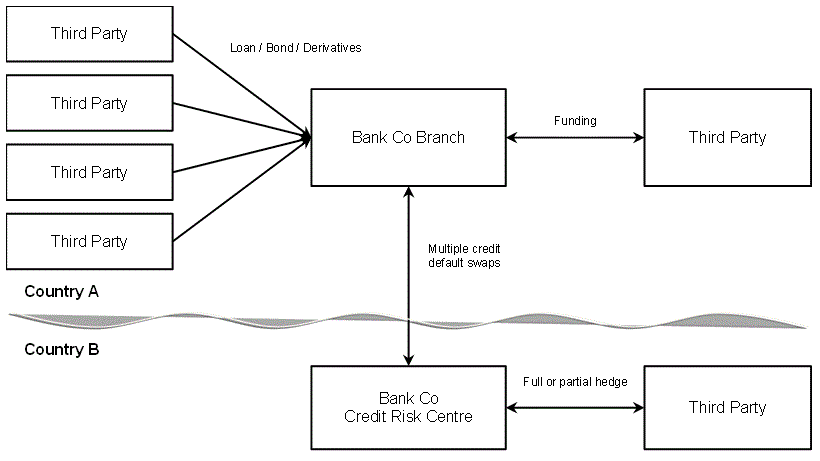
59. The foreign branch makes loans or purchases bonds from third parties, which are funded by third party borrowings of the Bank Co Branch (Country A). The head office in Country B (Bank Co) consolidates and manages its credit risk through a central credit portfolio trading book. The Bank Co Branch (Country A) hedges the credit or default risk of the loans or bonds with Bank Co (head office in Country B). In turn, the central credit risk centre within the head office manages the portfolio using a variety of instruments, including a total return swap, credit default swap or put option with third parties.
60. The proper attribution and allocation of gains and losses as between different parts of the bank is more complex than the low and medium complexity scenarios. The bank should expect that the Commissioner will undertake an even more detailed functional and comparability analysis in determining whether the outcome produced by reference to the internal derivative is in line with the arm's length separate enterprise principle.
Scenarios Dealing with Transactions that are Outside the Scope of this Guideline
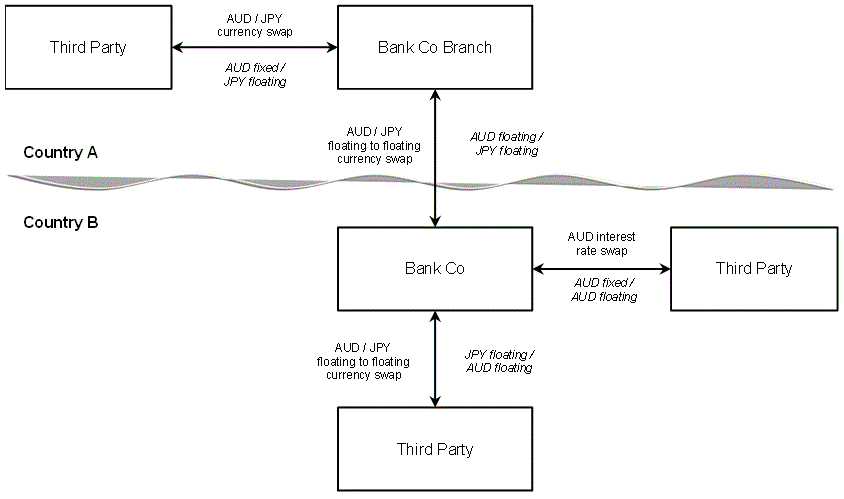
61. Bank Co Branch (Country A) enters into AUD/Japanese Yen (JPY) currency swaps with a third party to undertake a carry trade that is designed to take advantage of the differential between AUD and JPY interest rates. Bank Co Branch (Country A) transfers the currency risk to Bank Co (head office in Country B), which, in turn, enters into a series of transactions with third parties. This results in all of the market risk being defeased. The bank, as a whole, is fully hedged. However, the transactions leave the bank with an internal position between an AUD floating exposure and a JPY floating exposure, which, depending on movements in currencies and interest rates, will result in different income profiles as between Bank Co Branch and Bank Co.
62. This scenario is not within this Guideline as, based on a functional and comparability analysis, there is no commercial reason for the overall transaction. The outcome produced by reference to the internal derivative will not be accepted as representing arm's length dealings that are an appropriate proxy for the purposes of allocating or attributing the gains and losses generated by the transaction.
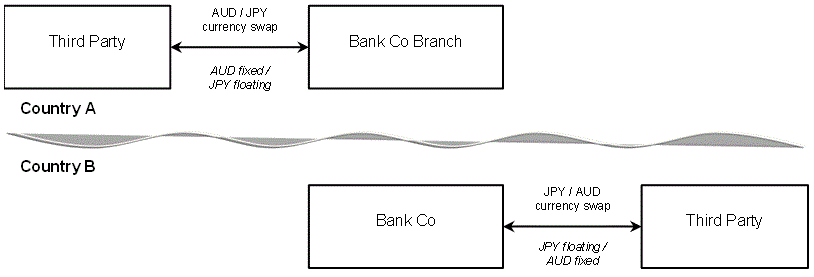
63. Bank Co Branch (Country A) records the transaction with the third party but the risk associated with the third party transaction is managed in Bank Co (head office in Country B). No internal derivatives have been recorded in this scenario and this Guideline therefore does not apply to the arrangements.
64. The proper attribution and allocation of gains and losses as between different parts of Bank Co must be based on the arm's length separate enterprise principle and requires a functional and comparability analysis to support the attribution. In the absence of an internal derivative, other transfer pricing adjustments should be made to compensate Bank Co (head office in Country B) for its risk management function and to ensure Bank Co Branch (Country A) does not derive gains or losses related to market risk where it does not perform such a function.

65. As with Scenario 13, no internal derivative is recorded. Bank Co Branch (Country A) records the transaction with the third party but the risk associated with the third party transaction is being managed in Bank Co (head office in Country B). The Commissioner would need to consider the proper attribution and allocation of the gains and losses of the third party transaction.
66. The proper attribution and allocation of gains and losses as between different parts of the bank is more complex than the low, medium and high complexity scenarios. In the absence of an internal derivative other transfer pricing adjustments should be made to compensate Bank Co (head office in Country B) for its risk management function and to ensure Bank Co Branch (Country A) does not derive gains or losses related to market risk where it does not perform such a function.
Commissioner of Taxation
26 May 2017
© AUSTRALIAN TAXATION OFFICE FOR THE COMMONWEALTH OF AUSTRALIA
You are free to copy, adapt, modify, transmit and distribute this material as you wish (but not in any way that suggests the ATO or the Commonwealth endorses you or any of your services or products).
Section 815-225(3) of the ITAA 1997 provides that actual expenditure includes losses and outgoings and actual income includes any amount included in assessable income.
This Guideline does not otherwise address how amounts determined by reference to an internal derivative are treated for income tax purposes. Banks will need to determine whether such amounts give rise to assessable income or allowable deductions in accordance with the income tax laws.
It would generally be expected that features (c), (d), (e) and (f) of the low complexity scenarios would be present.
Related Rulings/Determinations:
TR 2001/11
TR 2005/11
TR 2014/8
Legislative References:
ITAA 1936
ITAA 1936 23AH
ITAA 1936 121EB
ITAA 1936 160ZZV
ITAA 1936 Pt IIIB
ITAA 1997
ITAA 1997 Div 230
ITAA 1997 Subdiv 815-B
ITAA 1997 Subdiv 815-C
ITAA 1997 815-225(3)
TAA 1953
TAA 1953 Sch 1 Subdiv 284-E
